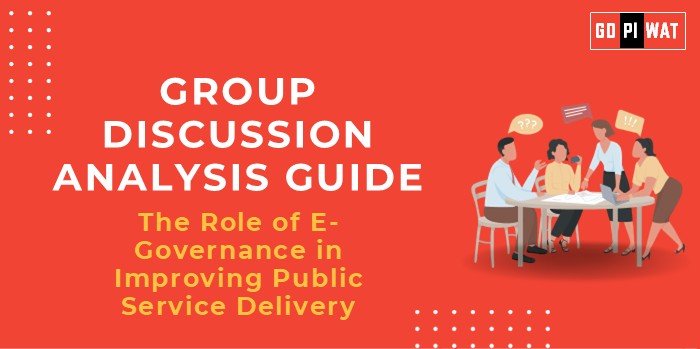📋 Group Discussion (GD) Analysis Guide
The Role of E-Governance in Improving Public Service Delivery
🌐 Introduction to the Role of E-Governance in Public Service Delivery
Context: E-governance has emerged as a transformative tool for public service delivery, particularly in developing nations like India, where challenges like administrative inefficiency, corruption, and lack of access are prevalent. It is globally recognized as a critical driver of transparent, efficient, and citizen-centric governance.
Background: Introduced to digitize governance, the concept gained traction in India with initiatives like Digital India, which focused on enabling e-governance through technological innovations like BharatNet and Direct Benefit Transfers (DBT). Recent events, such as the AIIMS cyber attack in 2022, also highlight its challenges.
📊 Quick Facts and Key Statistics
- 💳 Digital Transactions (UPI): 11.5 billion/month, reducing dependency on cash.
- 💰 Direct Benefit Transfers (DBT): Saved ₹2.7 lakh crore by eliminating middlemen.
- 🌐 BharatNet Coverage: Reaches 1.8 lakh gram panchayats.
- 📚 Digital Literacy (PMGDISHA): Trained 6.7 crore citizens in rural India.
- 📱 Internet Users in India: 900 million (2024), showcasing potential for scale.
🏗️ Stakeholders and Their Roles
- Government Agencies: Enablers of policy and infrastructure (e.g., BharatNet, MeitY).
- Private Sector: Technology providers for tools like DigiLocker and UPI.
- Citizens: Beneficiaries and participants in e-services.
- International Organizations: Benchmarks and technical collaboration (e.g., UN E-Government Survey).
🏆 Achievements and Challenges
✨ Achievements:
- Efficient Service Delivery: DigiLocker hosts over 400 million users.
- Cost Savings: DBT eliminated leakages, saving significant public funds.
- Rural Empowerment: Kerala achieved 93% digital literacy.
⚠️ Challenges:
- Digital Divide: Only 20% of rural households have stable internet.
- Cybersecurity Threats: The 2022 AIIMS attack exposed vulnerabilities.
- Infrastructure Gaps: Remote areas lack consistent connectivity.
🌍 Global Comparisons:
- 📈 Estonia: Global leader in e-governance with 99% of services online.
- 🤖 Singapore: Exemplifies advanced citizen engagement through AI-driven platforms.
🗣️ Structured Arguments for Discussion
- Supporting Stance: “E-governance has transformed public service delivery, as evidenced by DBT saving ₹2.7 lakh crore.”
- Opposing Stance: “E-governance is hindered by the digital divide, leaving rural areas underrepresented.”
- Balanced Perspective: “While e-governance drives efficiency, infrastructure and inclusivity must improve to achieve equitable benefits.”
💡 Effective Discussion Approaches
- Data-driven Start: “With 11.5 billion UPI transactions monthly, India leads global digital payments…”
- Contrast Opening: “While e-governance thrives in cities, rural areas face significant connectivity issues…”
- Counter-Argument Handling: Propose public-private partnerships to address challenges, citing examples like Rajasthan’s Digital District model.
📌 Strategic Analysis of Strengths and Weaknesses
- 🟢 Strengths: Cost efficiency, scalability, reduced corruption.
- 🔴 Weaknesses: Digital divide, cybersecurity risks.
- 🟡 Opportunities: 5G integration, AI-driven e-governance.
- ⚫ Threats: Data breaches, inequitable access.
📈 Connecting with B-School Applications
- Real-World Applications: Policy analysis, digital transformation case studies.
- Sample Questions:
- “How can AI enhance e-governance outcomes?”
- “What lessons can India learn from Estonia’s e-governance success?”
- Insights: Focus on digital literacy and innovative service delivery models.


